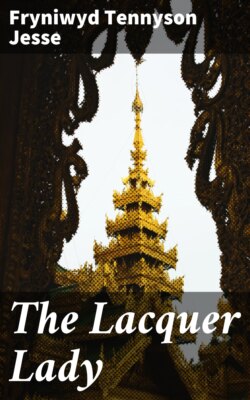Читать книгу The Lacquer Lady - Fryniwyd Tennyson Jesse - Страница 3
На сайте Литреса книга снята с продажи.
PREFACE
ОглавлениеTable of Contents
A PREFACE is a portentous thing and, coming from the author of a novel, may seem to imply an over-valuation, but it would not be honest to issue THE LACQUER LADY without thanking those people to whose expert knowledge I am deeply indebted.
To the late Rodway Swinhoe, expert in matters Burmese and “The Father of the Mandalay Bar”—I owe my first thanks, for it was he who told me the true story of the causes which led to the Annexation of Upper Burma—how it was “Fanny” and her love-affair, and not the pretext (justified as that would have been) of the Bombay-Burma Corporation that drove the Indian Government into action at last. Rodway Swinhoe was one of the earliest dwellers in Mandalay after the Annexation, and knew most of the people in the drama. He had planned to write the story himself, but with great generosity he gave it up to me, merely reserving to himself the right to publish a paper on the subject. That was a task that death did not allow him to fulfil. Rodway Swinhoe was the most generous of men, not only with the hospitality of his home, but with the hospitality of his mind as well.
I might, dazzled by the roundness and irony of the story—for, as it is no invention, I can say as much—have launched on the writing of it gaily enough, but I should soon have found it impossible to continue with any sense of confidence in my own statements had it not been for the expert help of others. There are only a few people left from those days—among them those whom I have called “Julie” and “Selah,” who both have helped me by long conversations, and the latter by written accounts as well. (“Fanny,” whom I met, is now no more.) Sir George Scott, k. c. i. e., the greatest living British authority on Burmese life and literature, and himself author of standard books that will always be vital to the serious student, has been my court of appeal throughout. He has given me vivid descriptions of the men of that day who made this particular piece of history. He has been my authority for all the Burmese words and phrases, and with unfailing patience he has “vetted” every line of the book.
Sir Herbert Thirkell White, k. c. i. e., one-time Lieutenant-Governor of Burma, has with his memories and research also helped me much.
In a most important matter—that of the Palace life—it is Mrs. Hosannah Manook, daughter of the Minister for Foreigners to the Court of Mandalay, and herself Maid of Honour to Supaya-lat, who has told me the things that no man, even a Burman, could have known. She has told me of the women’s side of the Palace. She is probably the last living person to whom those pages, closed for ever, are still fresh and vivid, and I owe her not only the details which have enabled me to reconstruct that strange and lost existence, but also the account of many episodes which have never found their way into the history books.
Monsieur Duroiselle, Superintendent of the Archæological Survey of Burma, was good enough to translate for me descriptions of ceremonies that he obtained from a scholarly Burmese friend who had been present at them.
So much that is inaccurate and false, both in main fact and in detail, has been written about the Golden Palace that I should have been afraid of adding to the list had it not been for the kindness of these experts; for though Blue Books, private reports of certain spies, and a privately printed diary have helped me much, these living brains, so generous with their memories and their knowledge, have done more.
Lastly, I owe thanks to Sir Harcourt Butler, Governor of Burma during both the winters I spent there, who did everything he could to help by giving me introductions and arranging visits for me.
The only thing that remains to be said is that I have in every case simplified the spelling of native names as much as possible. I might, to give only one example, have spelt Supaya-lat (which is a title meaning Middle Princess, and not really a name at all) in many different ways:—Su-pa-yaw-lat; Su-paya-lat; Soopayahlat (with hyphens to taste); and I might even have spelt it: Tsu-bhura-lat! I hope my readers will think I settled on the simplest version. Too many hyphens, such as might be strictly correct, for Burmese is a monosyllabic language, are irritating, and with no hyphen at all a very long word seems a horrid difficulty. In the same cause of simplification I have omitted accents whenever possible. The only deliberate inaccuracy in the book is that I have throughout referred to the Alè Nammadaw, or Centre Queen, by her best known title of Sinbyew-mashin. This, which means Lady of the White Cow Elephant, was a title only conferred on her after the death of the Chief Queen. But Sinbyew-mashin (here again I must ask the reader to believe that I have settled on the simplest spelling—how would he have liked to grapple with Hseng-hbyuma-sheng?) is bad enough; and to have called the lady one thing in the first part of the book and by this staggering name afterwards would have made a needless complication. I only mention this inaccuracy lest the pundits write and correct me.
